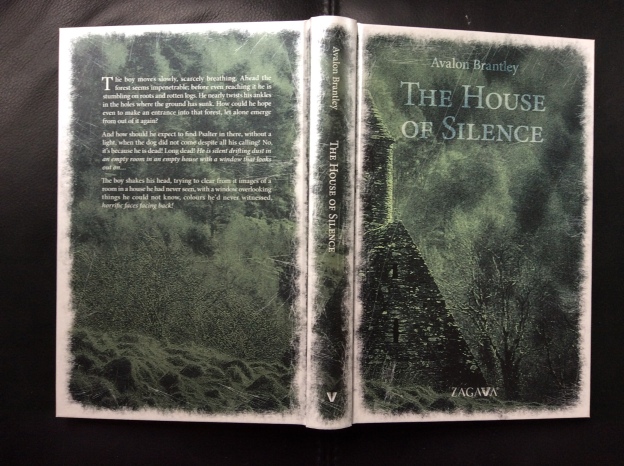
My previous review of TTA PRESS publications HERE
Stories by Jonathan L. Howard, Wayne Simmons, Nathan Hillstrom, Emily B. Cataneo, Christopher Mark Rose, Malcolm Devlin, Shauna O’Meara, Mark Morris, Helen Marshall, Joe Pitkin, Gwendolyn Kiste, Tim Casson.
When I real-time review the fiction in these two magazines, my thoughts will appear in the comment stream below…



 ENCYPHERED by Jonathan L. Howard
ENCYPHERED by Jonathan L. Howard
Copy of accompanying pamphlet above.
285 pages in a luxurious hardback shown in my first post above. Can you see the face on the front cover? In real life, it is invisible.
Liberally peppered with whole-page black and white images.
My copy is numbered 32/170.
FINDING FOUNDERED FOUNDATIONS
“The familiar landscape has changed, strangened, filling the boy with the suffocating certainty that he has not so much been benighted, but transported.”
Well, I have already been transported by what so far appears to be the unbelievable apotheosis of style that would appeal to those interested in texts by Hodgson, Poe, Lovecraft, Shiel, Ashton Smith… a 13 year old boy’s pareidoliac, ‘gluttonous’, ‘bruise-hued’ vision, running away from home again, with his now missing dog Psalter, the pit, the house. The face at the window. No justice can be done to it here, nor can I cover the backstory that ensues as Mr Acheson now plans, after the Second World War, to travel toward his past, relations and sweetheart, in Ireland, having been apprised of his father’s death there. Backstory of himself as a boy and young man in palimpsest with that parastory of the boy in his vision…? The ‘elsewise’ of an ‘ontological paradox’, notwithstanding. Acheson –> ache son?
III SCHOOL BELLE
“– another magical element of childhood expunged with the plunge into oldness.”
The spurge, too.
This book seems a new style for Brantley, accessible and engaging, yet retaining the tantalising feel of the tentacular wordiness, beauty, density, poetics of what I have read in her earlier books. This is sad as such a remarkable talent seems to be evolving, not in a straight line of improvement, but in a timeless variegation…and it is arguably a tragedy, too, in the circumstances. This promises, so far, to be a very important book, I feel.
Here the train journey to this outland in Ireland for reunion with his younger brother, and memories of the unrequited love in the earlier classroom he now rediscovers in the present day (a present day that is the past for us.) Underlain with the friction between the Anglicanism of our narrator and the Catholic environs, now and then.
“…Óengus the Culdee, later canonized Saint Óengus of Tallaght — his feast day was a month ago in fact — but at the time alluded to in the manuscript he was just a young eremitic man in cloak and reverse tonsure,…”
From busybodying gravestones ‘entitling’ their occupants, while narrator Ashley Acheson’s father’s coffin is being prepared in a backroom of the wake house, a coffin too small for the occupant’s shoulders, we now have this ‘reverse tonsure’, plus this meeting with an old school friend in a secluded church near the arguable remains of a Round Tower. We sense ancient awe here, a forbidden quality, something or other about, we also sense, this author and this book? Or have we just said not only the unsaid but the unsayable?
(With an added bonus of hearing bad organ playing; badly played familiar music often awakens its predictability into something else. God versus fallen angels?)
VI WAKING THE DEAD
“The silence in the house was massive. It made the structure feel small as a single room, or a wardrobe.”
Some very striking touches, as Acheson renews his acquaintance with those he used to know here a number of years ago, enough years to make the remembrances meaningful if distant, such as young ‘sin-swollen’ sexual beginnings, and his nephew who looks like Acheson did at that age, and we hear through the nephew Acheson’s late father (as he now lies in state in the wake house) speaking some last words about the House of Silence….and we learn more about Acheson’s life between, his hopes when running off to sea against his father’s wishes and his hopeless attempts to become a poet. The words and the sound of literal paper protests tell us more about words and poetry in his life, poetry as a craft, and many other aspects of eras in palimpsest with each other. Beautifully conveyed In a strange modern-ancient accessibility of al dente as well as plainer, but never simply plain, prose.
“…a chilling polyphony of keening,…”
“The child gave a naughty smile and hid behind her mother again.”
A stunning short chapter, of urgently replaced intention of grave site for the mourned corpse, a sunk well dug well or not well as a surprise morass of memories, as the loves, from Ashley Acheson’s past in this area, having been a wake’s co-carousers, are today co-mourners: women and girls or their own faery foundlings and changelings between. A mystery of trivial trinket or rich redolent amulet consigned to such well dug well? I am captivated, nay, too late – I am captured, I guess.
“…and the once whitewashed walls were now every colour of bruised and pallid corpseflesh, some of the chipped and mouldy surface broken away near the decrepit roof, revealing the crumbly masonry beneath, like the flesh of a forehead open to the skull.”
This is both traditional horror traditionally expressed and the powerful breaking news of something else within such a tradition of aura as well as of genius loci: a self-anciented House, where you once lived when much younger. A glimpse and skirmish upon you of a wild pig as HOdGson or an erstwhile unrequited lover or an inimical fuse of time as “some unnamed tributary of the River Shannon” or a denizen of “the nothinglands beyond”…?
Your forgotten tin whistle is still there.
“It wasn’t necessary to play so roughly with me, now was it Sir?”
This work leapfrogs and piggybacks itself, somehow. The journey by car through benighted wilds and steep drops, a vision of hit-and-running a lonely waif on the road, arrival at the house – just read this to gain a view of this house or spite your face, I say! And then a young girl riding on his back and a character falling over a crevasse, while excited about another round tower et al. Not to mention references to the Gadarene swine.
This book is, so far, gorgeously ominous, implicitly erotic, fey, feisty, pungent, exciting and word-worrying.
Might be the new old-fashioned horror classic you have been waiting for? Rare, and wildly conservative in its rule-breaking, if that is not a contradiction in terms.
“‘Just a large bog rabbit,’ O’Brien declared before swallowing another piece of it. A sliver of white emerged from his beard-hedged lips: a slender spike of bone, which he took with his fingers and clinked to the rim of his dinner plate.”
A substantive chapter of meal-taking as repast as well as info-dump through prandial conversations as re-past, I guess. Yet, it is not an info-dump, really, as you forgive this means of imparting information and atmosphere and backstory and character and history and religion … it slides down beautifully like some of the drinks they drink and the food they eat. And the turns of destiny that Ashley the narrator regrets or, rather, turns into new patterns of self, amid glances of sexy communion both during yesteryear (where be Amanda now? ) and now (Shannon at this this repast, who once stalked and fancied him as a boy) and her fey, feisty daughter Briga, like Shannon was in those old days. And Shannon’s father, O’Brien, the same age as me, but far more stolid a person than me, even if he only inhabits fiction?
I am just past halfway in this book and I sense it is already an important book that will haunt its author, wherever she is now. It must surely be, inter alios, a superior form of haunted-house-by-a-pit book, or at least on that borderland of another great author’s book in that form, an author whom or a scenario which she will by now no doubt have met or visited. Then beyond it. EVEN beyond it or him, with a traditional horror epic in retrocausal modern hyper-imaginative mode, towards literary nirvana, I suggest, with an old man’s lack of fear or favour.
We reach beyond even my own expectations, an apotheosis of literary rhapsody and rapture, helped by visionary powers as well as drunken ones, in this the narrator Acheson’s post-repast. There is so much highly hedonistic wordplay here, I can’ t even begin to choose quotes so as to demonstrate it. I do NOT exaggerate.
A vision of monstrous nightmare, later, then a purgatory or borderland of spurned erotic sex.
This is rare stuff, no mistake. It may be too rich for some reading tastes, but I can’t imagine any reader who manages to own this book spurning his or her own emotional affair with it, when push comes to shove, lush comes to love. It is difficult to understate or overstate this book.
XII THE STRANGE AMBIT
“, let alone alone with me,…”
“What was it about Shannon’s children that had me so on edge?”
Purgatory’s End or Land’s Border? The pit’s chasm beside the house?
This strange ambit is last night’s aftermath, including Ashley’s residual dreamss hungover.
One major character seems to have ‘legged’ it, representative no doubt of any reader who has also legged this soon-to-be-a-legend of a book, it being too rich for them, or too disturbing? I cannot imagine any such readers existing, though. If you are, I hope this review’s accompaniment in real-time helps you and prevents you from prematurely legging it.
Ashley does meanwhile meet some seeming strangers, this morning, in the environs of the house. New readers who have already caught up with us at this point?
Ashley also accompanies O’Brien et al on a hunt, and some of tbe mutated images pent up in my mind are upon the edge of fruition during these striking scenes.
And there is the promise of ‘flitting and flirting ‘ festive night tonight for homesteaders round about, for which event Ashley is to be Poet Laureate?
“, the book like a murdered bird in my lap.”
“…whose bole resembled writhing worms and whose roots bubbled up from the eroded soil.”
“…like a magician sheathing a trump behind a flowing sleeve.”
Ashley, having, as a boy, run away to sea, now submits himself to “this Sea of Sleep”, a grey area between singing along with the festivities of the Eyes Wide Shut festival, where a vision of Amanda emerges, and then entering a vision so significant of shadows and shapes, even, as an implicated reader of it, one needs to check one’s own madness meter. There are moments here on which I had to double-take. Is this Óengus, not a million prophetic miles away from the Orange of today’s Marmalade Mussolini. The Pit, is that the evidence of the one-who-legged-it receiving the proof of his Round Tower and the Church that the Pit once engulfed?
This chapter seems frankly to be the book’s own pivot, some sort of tipping-point whereby to decide whether this novel works as a meaningful classic of horror literature or an incredible mad one. Either a gratuitous nightmare supreme or something far more prophetic, far more important, about our turbulent times today? Maybe all we readers should triangulate the various findings in our own gestalt real-time reviews to address the nature of this pivot, if pivot or tipping-pit it is.
“If anyone reads this ever they’ll think I’ve gone mad! I may in fact be going mad, who can tell? Not I, not if I have!”
…which seems to bear out my checking my own madness meter, yesterday. But today, my doubts are dispersed by the cathartically rich language, the arcane thrust of its words, the fact that I have submitted myself to its sometimes hairy or edgy care. Its portrait of a bloodthirsty magical woodland masque. Acheson, here in this chapter, too, seems to be prolific with his own verse, here under the tutelary-seeming presence of Shannon, when before in England he wrote little verse. The Brantley soul, too, seems to flourish more under its own creation of these scenes, I sense. The bilberry hunting with the children. The fighting antics of Acheson with stripling young men that he shares with us here in his diary-remodelled-by-Brantley-as-novel. And the parallel of rôle-playing in the masque with entities such as the swine-thing he saw earlier. Interface of artifice and truth, of horror and hedonism, each pair making one true and the other not, but not always in that order. The crowd of blackbirds from the pit…
The monster in the nest, like a cuckoo, with “an appetite that would have trumped all her other young combined!” And… “We tromped for ages through the long shady stretches of river-riven woods,…” and the idyllic scene in the perfect last sentence of this chapter, a sentence with “orange fire.”
XVI THE STRANGER ORBITS
“Green things perished…”
O’Brien, like me, is about the same age as the Trump. Although Brantley probably never lived to see the full enormity of Trump evolve? That dead sun evolved in Hodgson, and Byron’s Darkness poem, now reborn here even deader, more cataclysmic. This novel is an apotheosis. It is where, possibly, we have always been reading towards? Becoming a subsumptous orgy of words. The ultimate Night Land.
In these two chapters, we can discern, if you read with attention, a series of alliterative words in threesomes (that I won’t quote here; too easy to over-quote this book), and another threesome being the Amanda-Shannon-Briga conflux and onward relay-bâton passing of concupiscence….
“…with less room in my trousers than before.”
Both poetic and gauche. As if written with a brain sloshing in the skull? And with the highest possible inspiration that, unless told otherwise by those in the know, we must assume was responsible for killing the author, otherwise such inspiration would not have been possible at all? An important question.
The seething Swine-pit. Alongside the barrel- and spirit-intoxicated madness, again, till another wakening, in the next chapter, yet to be read, I guess…
“This is a new major horror classic tapping into Hodgson’s Borderland in a staggering blended style of horror greats, and above all of the late young Avalon Brantley who agreed its publication seemingly just before she sadly passed away…”
XVIII THE SEASON OF STIRRING AND RESURGENCE
“Had I, in some inexplicable yet tangible way, gone bodily from this place,…”
“…the Tir na nÓg that lies over the dark ocean of Space-Time:”
Another movement of madness and aftermath, this time, as I somehow predicted earlier, “a full-on rolling-around-on-the-ceiling bloody madness!”
No wonder readers as well as, imputedly, the author herself, has touched or is about to touch such lethal madness? Here he sees “a trio of child-size figures”, naked children, it seems, and the season has become Autumn and the configurations of buildings reconfigure, including the Round Tower, and his terrified climb to its sky-high dungeon, escaping something from the Pit you will not be able to cease visualising once you’ve seen it through these words.
Worth reaching the resigned aftermath simply so that you could first be Terrifid to the soul, Terrified without end. It is no accident that Terra where you walk assonates…
“I do not remember writing that.”
XX BLACK WATERSHED
XXI WHITE MARTYRDOM
“And then he said something to me — something horrible — something I will never allow to disgrace the pages of this journal,…”
These last chapters, two of them relatively short. This work is a “spiritual fingerprint”, and I still hear her voice even after closing the covers, as somehow the journal-keeper Acheson, Colums of Ache’s son, does, too.
But before that, men and women mutate before our very reading-eyes, in this embattled climax. I also sense things here unintended, like explicitly mixing up the daughter with the mother, as I often do with Melania and Ivanka, despite tellingly their different colour hair, not that one is mother of the other in the known A-meandering tributaries or effulgent kingdoms of or off the father’s thrust, Avalon or Shannon…
I have no reason to change anything I wrote above on this whole webpage in earlier real-time. This work transcends its own (uniquely and adeptly stunning in itself) feasting goriness and melodrama of visionary myth and retribution. A Redoubt is the strongest certainty of all.
A New-found Horror Classic that should be read advisedly, because the Horror is somehow real and today I am one of us few readers so far still in its experiential aftermath…till thousands or mutable millions flock to join us here tomorrow?
end